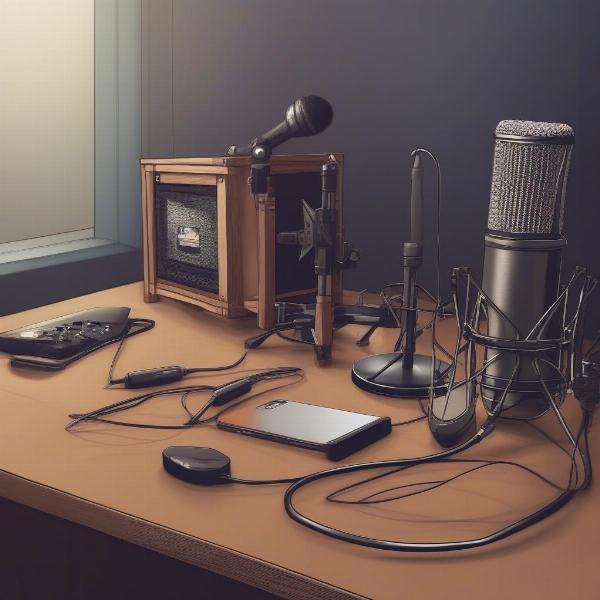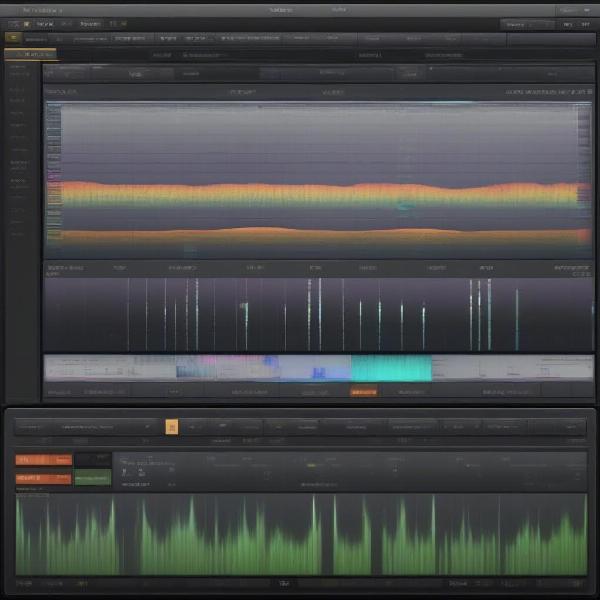Creating compelling game sound effects is crucial for immersive gameplay. Whether you’re developing a sprawling RPG or a simple mobile game, sound effects breathe life into your virtual world. This guide will delve into How To Create Game Sound Effects, covering everything from recording original sounds to using software and implementing them effectively.
After this detailed exploration of game sound design, you’ll be well-equipped to elevate your projects with professional-quality audio. We’ll cover both basic and advanced techniques, offering insights for beginners and seasoned developers alike. Let’s get started!
Creating impactful game sound effects doesn’t have to be daunting. With a bit of creativity and the right tools, you can craft audio that enhances the player experience. One fundamental aspect is understanding your game’s genre and overall atmosphere. A whimsical platformer demands different sound effects than a gritty survival horror game.
Think about the actions, environments, and characters in your game. Each element requires unique audio cues to convey its presence and purpose. For example, the sound of a sword swing in an RPG should feel weighty and powerful, while the chirping of birds in a peaceful forest scene should evoke tranquility. Careful consideration of these aspects will guide you in making appropriate sound design choices. Similar to how you would how to make a game on an ipad, understanding the platform’s limitations and strengths is crucial for optimizing sound effects.
Recording Original Sound Effects
Recording your own sound effects allows for maximum creative control and ensures unique audio for your game. This can range from simple foley recordings to complex layered soundscapes. You don’t need expensive equipment to get started; even a basic microphone can produce usable results.
Essential Equipment for Recording
- Microphone: A decent quality condenser microphone is ideal for capturing clear and detailed audio.
- Recorder: You can use a digital audio workstation (DAW) on your computer or a portable recorder.
- Headphones: Closed-back headphones are recommended to prevent audio feedback during recording.
Techniques for Recording Sound Effects
- Foley: Foley is the art of creating everyday sound effects using various props. Experiment with different materials to create unique sounds for footsteps, impacts, and other actions.
- Field Recording: Capture sounds from your environment, such as ambient noises or specific object sounds.
- Synthesized Sounds: Use software synthesizers to create electronic sounds or manipulate existing recordings.
Using Software to Create and Edit Sound Effects
Several software programs are available to help you create and modify game sound effects. These range from free audio editors to professional DAWs. Choosing the right software depends on your budget and technical skills.
Popular Sound Design Software
- Audacity (Free): A powerful open-source audio editor suitable for beginners.
- Adobe Audition (Paid): A professional-grade DAW with advanced features for sound design.
- FL Studio (Paid): A comprehensive music production software that can also be used for sound design.
Basic Editing Techniques
- Noise Reduction: Remove unwanted background noise from your recordings.
- Equalization (EQ): Adjust the frequencies of your sounds to achieve the desired tonal balance.
- Compression: Reduce the dynamic range of your audio to make it sound more consistent.
 Recording Game Sound Effects with Microphone Setup
Recording Game Sound Effects with Microphone Setup
Implementing Sound Effects in Your Game
Once you’ve created your sound effects, the next step is implementing them into your game engine. Most game engines have built-in audio systems that allow you to trigger sounds based on in-game events. For example, consider how you would implement sound in how to make an android game. Understanding the specific platform and its audio capabilities is crucial for seamless integration.
Key Considerations for Implementation
- File Format: Most game engines support common audio formats like WAV and MP3.
- Looping Sounds: Create seamless loops for ambient sounds or background music.
- Volume and Panning: Adjust the volume and stereo placement of your sound effects to create a realistic soundscape.
Advanced Sound Design Techniques
As you gain experience, you can explore more advanced sound design techniques to create even more immersive audio. This can involve layering sounds, using effects like reverb and delay, and creating dynamic audio systems that respond to gameplay.
Layering Sounds
Combining multiple sounds can create complex and interesting effects. For instance, layering the sound of a gunshot with the sound of shell casings hitting the ground adds realism. This approach contributes to a more detailed and engaging soundscape.
Using Effects
Audio effects such as reverb, delay, and chorus can enhance your sound effects and create a sense of space and atmosphere. Experiment with different effects to find what works best for your game.
 Editing Game Sound Effects in Software
Editing Game Sound Effects in Software
Sound Design for Different Game Genres
Different game genres require unique approaches to sound design. Consider the tone and style of your game when creating sound effects. For a lighthearted game like one created in how to make a jump game in scratch, the sound design will be fundamentally different from that of a more realistic simulation game.
Action Games
Action games often rely on impactful sound effects to emphasize the intensity of gameplay. Explosions, gunshots, and other high-energy sounds play a crucial role in creating an adrenaline-pumping experience.
RPGs
RPGs often feature a wide variety of sound effects, from environmental ambiences to character voices and magical spells. Creating a rich and diverse soundscape is key to immersing players in the fantasy world. This is similar to the challenges faced when creating a complex project, such as how to make an idle game in godot, which requires a deep understanding of the engine’s features and capabilities.
Puzzle Games
Puzzle games often use subtle sound effects to provide feedback to the player. Clicks, chimes, and other minimalist sounds can be effective in communicating progress and success. This is where thinking about the user experience, as you would when learning how to make an ios game, comes into play in the sound design process.
Conclusion
Creating game sound effects is a multifaceted process that involves creativity, technical skill, and a deep understanding of your game’s vision. By utilizing the techniques and tools outlined in this guide, you can create compelling audio that elevates your game to the next level. Start experimenting with different approaches to how to create game sound effects and discover what works best for your projects.
FAQ
- What is the best microphone for recording game sound effects? There isn’t one “best” microphone, but a good quality condenser microphone is a great starting point.
- Is expensive software necessary for creating game sound effects? No, free software like Audacity can be very effective.
- How do I implement sound effects into my game? Most game engines have built-in audio systems that make this process relatively straightforward.
- What are some common mistakes to avoid when creating sound effects? Overusing effects, neglecting proper mixing, and using low-quality recordings are some common pitfalls.
- How can I make my sound effects more realistic? Layering sounds, using appropriate effects, and paying attention to detail can greatly enhance realism.
- Where can I find free sound effects for my game? There are several online resources offering free sound effect libraries.
- How important is sound design in game development? Sound design is crucial for creating an immersive and engaging player experience.

